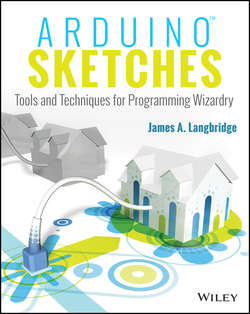Читать книгу Arduino Sketches - Langbridge James A. - Страница 12
На сайте Литреса книга снята с продажи.
Part I
Introduction to Arduino
Chapter 1
Introduction to Arduino
The ATmega Series
ОглавлениеAtmel has placed its AVR design into different groups, depending on various factors. There are numerous AVR microcontrollers, and knowing which one to use is essential for projects. Some ATmega devices have more memory, or more digital and analog inputs and outputs, or have a specific package size.
The ATmega Series
The Atmel megaAVR is the muscle of the AVR series. They are designed for applications requiring large amounts of code, with flash memory ranging from 4 k all the way to 512 k, enough for the most demanding of programs. Atmel megaAVR devices come in various sizes, ranging from 28 pins all the way to 100 pins. These devices have an impressive amount of embedded systems: analog to digital converters, multiple serial modes, and watchdog timers, to name but a few. They also have a large amount of digital input and output lines, making them ideal for devices that communicate with numerous components.
There are close to 100 ATmega devices, ranging in flash memory size and package size, and some models have advanced features such as internal LCD Controllers, CAN controllers, USB controllers, and Lightning controllers. ATmega chips are found in almost every Arduino board produced.
You can find more information on the ATmega series on Atmel's website at: http://www.atmel.com/products/microcontrollers/avr/megaavr.aspx.
The ATtiny Series
The Atmel tinyAVR series has small-package devices designed for applications that require performance and power efficiency. These devices live up to their name “tiny”; the smallest tinyAVR is 1.5 mm by 1.4 mm. The word “tiny” is only a reference to their size. Their power is comparable to the larger AVRs; they have multiple I/O pins that can be easily configured and a Universal Serial Interface that can be configured as SPI, UART, or TWI. They can also be powered with as little as 0.7 V, making them highly energy-efficient. They can be used in single-chip solutions or in glue logic and distributed intelligence in larger systems.
There are more than 30 ATtiny devices, and they come with between 0.5 k and 16 k of flash memory, and range from 6-pin packages to 32-pin packages. You can find more information on the ATtiny series on Atmel's website at: http://www.atmel.com/products/microcontrollers/avr/tinyavr.aspx.
While the ATtiny series are powerful devices given their size, no Arduino uses this device as its microcontroller.
Other Series
Atmel also has different AVR series: The XMEGA series deliver real-time performance, with added encryption using AES and DES modules, and includes an interesting technology, the XMEGA Custom Logic, reducing the need for external electronics.
Atmel also produces a 32-bit version of its AVR microcontroller: the UC3. Supporting fixed-point DSP, a DMA controller, Atmel's famous Peripheral Event System and advanced power management, the UC3 is a formidable microcontroller. You can find more information on Atmel's AVR website at: http://www.atmel.com/products/microcontrollers/avr/default.aspx.
